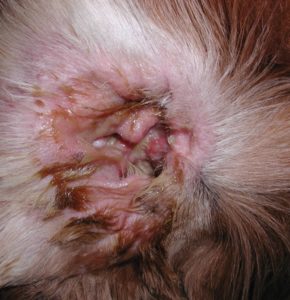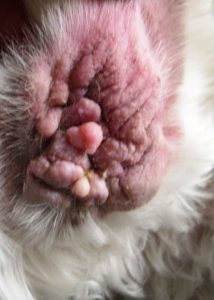External ear disease – allergy is frequently a primary cause
The common ear inflammation and infection in the dog most frequently affects the external ear canal. External ear disease are a very common challenge faced by pet owners and vets alike. Its causes are numerous and almost always there is an underlying primary disease. One of the most common and frustrating primary causes of external ear infections is allergy – most commonly food allergy or environmental allergy(atopy). The primary allergic cause alters the structure of the ear canal lining, its natural defences, and ability to self clean. Other primary causes (that are more commonly seen as short-term/acute problems) include parasites, grass awns, tumours, hypothyroid disease and abnormal skin formation (called keratinization disorders).
Secondary infections and the battle at home
Secondary infections with many types and bacteria and some fungi are common, and are often very stubborn and difficult to treat. These infections can go on for months, and often years, and the microbes evade the skin immune system with biofilms that enhance their chances of survival and make the infections very difficult to manage. If these infections are left to progress, the ears become permanently scarred, narrowed, and sore. In many cases, middle ear infections are present and may prevent resolution of what appears to be a simple ear infection. Deafness, balance issues and unrelenting discomfort are not uncommonly seen.
- Stubborn Pseudomonas bacterial ear infection
- Long term scarring from poorly managed otitis externa
Early and effective management of ear infections is ideal
The best way to manage external ear infections is ideally to diagnose the primary cause early in life, and manage it well before permanent changes occur. Many cases seen by dermatologists have already developed chronic changes, however these cases can still be well managed with the right approach.
For further information on management of external ear disease, please see:
https://inpractice.bmj.com/content/38/Suppl_2/17


